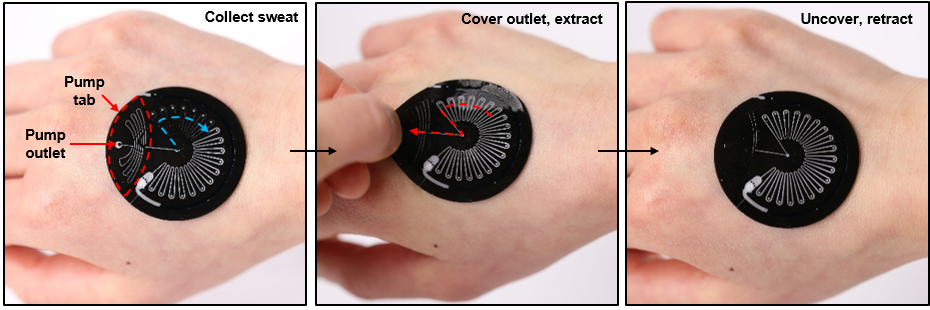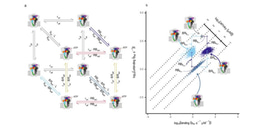Wearable hydration monitor with feedback you can feel
Published in Electrical & Electronic Engineering

The ability to non-invasively monitor physiological status such as electrolyte, hormone, metabolite, and stress biomarker concentrations has important implications in continuous health and athletic performance monitoring. Collecting and analyzing sweat in situ is particularly powerful in athletic settings, as it can provide athletes, trainers, and physicians greater insight into sweat rates and composition of individual athletes in real time. New classes of soft, epidermal microfluidic (epifluidic) devices have been developed in order to provide real time, personalized monitoring and analysis of important hydration biomarkers during athletic events. However, current versions of these systems are limited by 1) inaccuracy after rehydration, and 2) lack of instantaneous feedback to the user.
Here, we developed a set of microfluidic components which allow epifluidic devices to be reset to their original state and deliver a skin sensation directly to the skin at high levels of sweat loss. A reset system comprising manually actuated elastomeric pumps and valves enables manual ejection of sweat after rehydration. When a pull tab on the device is strained, a normally closed valve opens and a pressure differential is created, thus suctioning the sweat from a collection channels Releasing the pull tab allows for sweat to be completely purged for the device, allowing for repeated emptying of the collection channel. To enable visual readout, we developed a dye-less visual indication material which provides capabilities for reversible, real-time sweat volume readout. We created a micropatterned corner-cube capping layer for the microchannels which scatters ~60% of incident light and thus appears white when the channels are vacant. The comparable refractive index of sweat and the microchannel material reversibly eliminates this scattering effect during ingress of fluid into the channel, yielding a black color as dictated by the device background.

Figure 1. Reset system enabled by elastomeric pumps and valves and dye-less visual indication material.
Delivering an alert to an athlete during competition is complicated by the natural motions of the body and the athlete’s focus on their performance. We wanted to deliver a strong, safe sensation to the skin at high levels of sweat loss using a delivery system free of electronics to minimize device complexity. Here, we developed a system which ejects a skin sensitizer onto the skin to induce a strong but safe sensation, even during vigorous activity. Liquid compounds of menthol, the molecule responsible for the cooling sensation in peppermint, and capsaicin, the molecule responsible for spicy foods, served as skin sensitizers. An effervescent pump comprised of a small foaming tablet ejected the skin sensitizer agent at predetermined levels of sweat loss. This reaction is triggered when sweat enters a chamber containing an effervescent foaming tablet, creating a fluidic pressure which expels the skin sensitizer. Leveraging collected sweat as the input energy for an effervescent reaction negated the need for bulky power sources such as batteries.

Figure 2. Sweat enters chamber with effervescent foaming tablet and expels skin sensitizer onto skin.
Motion and deformation associated with athletic performance presented challenges in developing wearable systems. To evaluate the stability and efficacy of these systems, I tested the device weekly at the gym during running, biking, or in the sauna. We tested dozens of valves, pumps, channel geometries, and concentrations of skin sensitizer agents until we found a combination which could withstand intense physical activity and deliver timely alerts to the skin at high levels of sweat loss. We hope that these microfluidic devices produced by the hard work and sweat (literally) of myself and the coauthors, will lead to new methods of real time hydration tracking and feedback.
These results were recently published in Nature Communications:
Follow the Topic
-
Nature Communications

An open access, multidisciplinary journal dedicated to publishing high-quality research in all areas of the biological, health, physical, chemical and Earth sciences.
Related Collections
With Collections, you can get published faster and increase your visibility.
Women's Health
Publishing Model: Hybrid
Deadline: Ongoing
Advances in neurodegenerative diseases
Publishing Model: Hybrid
Deadline: Dec 24, 2025




Please sign in or register for FREE
If you are a registered user on Research Communities by Springer Nature, please sign in